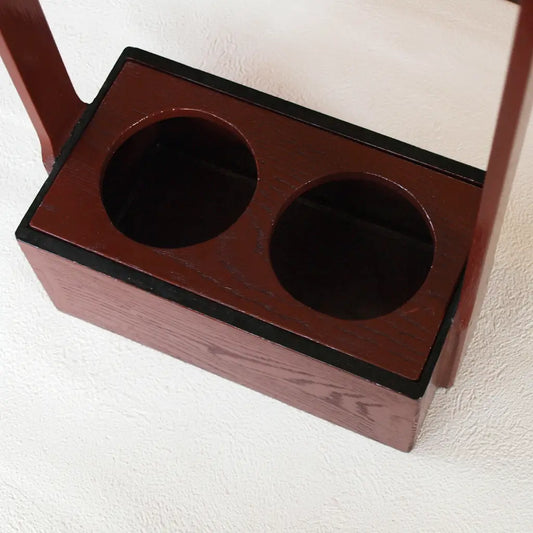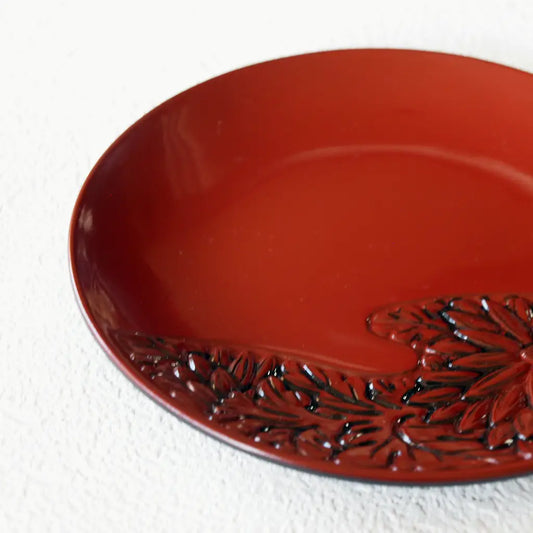The Appeal of Kiso Lacquerware | The World of "Toshu," a Proof of Handicraft
The world of lacquerware: The philosophy of Kiso lacquerware that cultivates the individuality of unique pieces
Kiso lacquerware, which was developed in the post towns along the Nakasendo road, is attractive for its durability and diverse techniques.
It has a variety of different expressions, including Kiso Shunkei lacquer, which brings out the beauty of the wood, and Kiso Tsuishu, which is made by grinding away multiple layers of lacquer.
It is within this diverse range of lacquering that we pursue the world of " lacquer elegance."
"Lacquer elegance" is the natural breathing of lacquer and the inevitable individuality carved into it by the artisan's hands, in other words, the proof of handwork. We respect all of the unevenness in appearance, such as uneven lacquering, color unevenness, brush marks, lacquer clumps (puddles), and material rust (unevenness in the wood surface), as the unique characteristics of each piece.
The inherent depth and charm of lacquerware cannot be expressed through uniform beauty.
We believe that this "finishing charm" is a unique expression that is nurtured by the affection of the user, and is the new value (appeal) of Kiso lacquerware .
For more information on the concept of "Nurishu" and its profound philosophy, please see "The individuality of lacquerware and the world of lacquer charm" Please see here for more details.
[600-year-old roots] The warmth that Kiso lacquerware brings to modern life and the durable techniques that have been passed down through the generations
Kiso lacquerware, nurtured by the rich nature of Kiso and the skills of its artisans, has roots dating back approximately 600 years and has been around for over 400 years, bringing warmth and beauty to modern life. We will explore the charm of this lacquerware, which combines robust practicality with sophisticated design.
The background of the birth of Kiso lacquerware
Kiso lacquerware has developed in a unique way, with the rich natural environment, its history as a post town, and technological innovation interacting with each other.
1. Rich natural environment:
-
Abundant timber resources: The Kiso region produced an abundance of high-quality timber, including cypress, sawara, and zelkova. These timbers were suitable for making the base wood for lacquerware. Cypress, in particular, was used for high-quality lacquerware because of its beautiful grain and minimal warping.
-
A climate ideal for growing lacquer: Kiso has a cool, humid summer and cold winter, making it ideal for growing lacquer trees ( urushi ). This made it possible to harvest lacquer locally, which became the foundation for lacquerware production.
- Pure water: Pure water is essential for the refining of lacquer and the manufacturing process of lacquerware. Kiso has an abundant water source, which supported the production of high-quality lacquerware.
2. Historical Background:
-
Development as a post town on the Nakasendo road: During the Edo period, the Kiso region flourished as an important post town on the Nakasendo road. With many travelers passing through, Kiso lacquerware, being durable and practical, became a popular souvenir. In particular, in Narai-juku, the "Oroku Kushi," a lacquered comb, became a local specialty and drove the development of the lacquerware industry.
- Protection by the Owari Tokugawa Clan: During the Edo period, the Owari Tokugawa Clan protected Kiso's timber resources and encouraged the lacquerware industry, which led to the improvement of techniques and the establishment of a production system.
3. Innovation:
-
Discovery of "Sabi-tsuchi": In the early Meiji period, a high-quality clay called "Sabi-tsuchi" was discovered locally, which is essential for creating the base for lacquer. By using this sabi-tsuchi, it became possible to create lacquerware that was stronger and had a smoother finish than conventional lacquerware, dramatically improving quality. This led to Kiso lacquerware developing not only as an everyday item, but also as luxury furnishings.
-
Diverse lacquering techniques: Kiso lacquerware has developed a variety of techniques, including "Shunkei lacquering," which brings out the beauty of the wood, "Tsuishu lacquering," which creates patterns by applying multiple layers of lacquer, and "Nuriwake Roiro lacquering," which creates patterns with colored lacquer. These techniques have enhanced the artistry and functionality of Kiso lacquerware.
-
Inherited traditions and techniques: Handcrafted techniques that have been passed down from craftsman to craftsman for 400 years. While preserving these traditions, we also incorporate new designs and techniques to keep up with the changing times.
-
Nationally recognized lacquerware center: In recognition of its advanced techniques and historical value, Kiso has been designated as an important lacquerware center. It has also been certified as a first-class traditional industry production area.
- Highly acclaimed both at home and abroad: It has won numerous top awards at national lacquerware exhibitions, and its high quality and beauty are widely recognized.
What is Kiso lacquerware?
Lacquerware is made in the Kiso region of Nagano Prefecture using traditional methods, primarily from cypress and other woods. A wide range of products are produced, from everyday items used in daily life to highly artistic crafts.
Hirazawa lacquerware and Kiso Shunkei
In particular, Hirasawa in the Kiso Valley (now Kiso Hirasawa, Shiojiri City) and Fukushima have long been known for their distinctive lacquerware production. Hirasawa lacquerware , which is said to have begun in the Keicho era, was a popular souvenir for travelers during the Edo period, when the town was a bustling post town on the Nakasendo road. Kiso Shunkei , which makes use of the beautiful, translucent grain of the wood, is a lacquering technique representative of this region.
Nakasendo Post Towns and Kiso Lacquerware
During the Edo period, Kiso flourished as an important post town on the Nakasendo road, and lacquerware became popular as a special item to commemorate the journey. In particular, in Narai-juku, the "Oroku combs" made in Yabuhara, decorated with gorgeous maki-e lacquerware, became popular and were purchased by many travelers.
Four characteristics that support Kiso lacquerware
1. Abundant timber resources
This area has long been blessed with high-quality wood, including the Kiso Five Trees, known as "Asahi Neko" (Asunaro, Sawara, Hinoki, Nezuko, and Koyamaki). Wood that grows slowly in the cold climate has a dense, beautiful grain, making it the base for durable lacquerware.
2. A climate suitable for lacquerware production
The Kiso region experiences cool summers and bitterly cold winters. This temperature difference, along with the flow of the Shinano River system, which brings just the right amount of humidity, creates the perfect environment for the lacquer to dry and harden. The enzyme "laccase" contained in lacquer is activated under these specific climatic conditions, reacting with moisture in the air to form a strong coating.
3. Rust clay creates a strong base
One of the major characteristics of Kiso lacquerware is the "sabi clay" that creates a base so hard that it is said that "not even a blade can hold it." By mixing this locally produced clay with lacquerware, it is possible to produce lacquerware with durability comparable to Wajima lacquerware, using only local materials. This clay forms the foundation that supports a wide range of products, from tableware for everyday use to high-end lacquerware with intricate decorations.
4. Inherited traditions and techniques
It's not just the lacquerware-making techniques that have been cultivated in the harsh natural environment of Kiso. It's also the spirit of the artisans that has been passed down through generations. From the selection of materials, to the processing of the wood base, to the delicate inner layers of lacquer that are applied multiple times, the uncompromising handiwork of artisans produces beautiful and durable Kiso lacquerware. The world of lacquer
The charm of Kiso lacquerware, loved throughout the ages
1. Unique beauty where history and culture live on
Kiso lacquerware, which has been refined over 400 years of history, is not just an everyday item. It is a work of art that embodies the climate of Kiso, the skills of its artisans, and the Japanese aesthetic sense. Unique techniques such as carved lacquer and Kiso lacquerware create a unique depth and warmth, and the more you use it, the more you will grow to love it. Deeply rooted in Japan's food culture and lifestyle, it enriches and colors your daily life.
2. A variety of techniques create a rich range of expressions
The appeal of Kiso lacquerware lies in its diverse coating techniques.
-
Kiso Shunkei lacquerware : A technique that brings out the beautiful grain of wood and finishes it with a transparent lacquer. It brings out the natural warmth of the wood and adds a gentle touch of color to your dining table. (Designated as a traditional craft by the Ministry of Economy, Trade and Industry)
-
Kiso Tsuishu : A technique that creates unique patterns by applying multiple layers of lacquer and carving out the layers. Its appeal lies in its deep color and the warmth that can only be achieved through handwork. (Designated as a traditional craft by the Ministry of Economy, Trade and Industry)
- Nuriwake Roiro-nuri: A technique that creates a vivid, deep luster by drawing geometric patterns with vibrant colored lacquer and then carefully polishing it. It gives a modern impression. (Designated as a traditional craft by the Ministry of Economy, Trade and Industry)
These diverse techniques not only add color to the dining table, but also bring rich expression and warmth to living spaces. In 1991, the tools and products used in these production processes were designated as Important Tangible Folk Cultural Properties of Japan, and in 2006, Kiso Hirasawa in Shiojiri City was designated as an Important Preservation District for Groups of Traditional Buildings.
3. Proven practicality that fits into everyday life
Kiso lacquerware is not only beautiful in appearance, but also highly durable and practical. It is resistant to deformation even when hot food is placed inside, and can keep cold food cold, making it a safe choice for everyday use at the dinner table. Its durability also makes it appealing as a long-lasting favorite that can be enjoyed for generations to come. In recent years, its sophisticated design has been rediscovered, and it is gaining attention as an item that blends naturally into modern lifestyles.
4. Reliable quality, embodied in the skill and passion of artisans
Each piece is carefully and lovingly crafted by artisans with many years of experience. From the selection of materials to the creation of the wood base and the breathtakingly delicate lacquering process, the artisans' uncompromising skills and passion produce high-quality lacquerware that will be loved for generations. When you hold a piece in your hand, you can feel the artisan's soul in its smooth texture and deep colors.
5. Connecting tradition to the future and creating new value
While preserving the traditional techniques that have been cultivated over 400 years of history, Kiso lacquerware artisans are constantly pursuing new possibilities.By continuing to innovate while preserving tradition, such as by creating designs that suit modern lifestyles and combining them with new materials, the future of Kiso lacquerware is expanding even further.
6. A high-quality presence that creates a rich time and space
Living with lacquerware enriches your everyday dining table and transforms ordinary moments into something special. Its beautiful appearance gives the table warmth and elegance, enriching the soul of the person who uses it. Kiso lacquerware will add a special charm to meals with loved ones or special moments when entertaining guests.
7. A memorable gift that conveys your precious feelings
Its beauty and practicality make it an ideal gift for celebrations. Whether it's a wedding, housewarming, or longevity celebration, it will convey the giver's heartfelt feelings and be treasured for a long time. Kiso lacquerware is more than just a product; it is a symbol of the giver's warm feelings.
8. Experience the charm of lacquerware in Kiso
The Kiso region is dotted with Kiso lacquerware workshops and galleries. Come and actually pick up the lacquerware and feel its smooth texture, deep colors, and the breath of the artisans. Direct contact with the artisans will be a valuable opportunity to gain a deeper understanding of the appeal of Kiso lacquerware.
9. Connecting to the future: traditional Japanese crafts
Kiso lacquerware is an irreplaceable cultural heritage that conveys the beauty of traditional Japanese crafts. Our mission is to connect this precious tradition to the future and create new value. We hope to continue to share the beauty and techniques of Kiso lacquerware with many people.
Experience and purchase Kiso lacquerware
Why not experience the charm of Kiso lacquerware more deeply and find your favorite piece?
-
Event information: Kiso Lacquerware Festival and Narai Post Town Festival
Kiso Lacquerware Festival and Narai Post Town Festival : Held every year on the first weekend of June. This lively festival not only features an exhibition and sale of lacquerware, but also allows you to experience the traditional culture of Kiso. The annual lacquerware sale is held throughout Hirasawa. This is your chance to get your hands on Kiso lacquerware at a bargain price.
Naraijuku Ochatsubo Dochu: A procession of people dressed in Edo period costumes, giving you a sense of historical beauty.
-
Stops:
Kiso Narakawa Roadside Station - Kiso Living Crafts Museum: Along with local specialties, you can easily purchase Kiso lacquerware for everyday use. A facility that brings together a variety of Kiso's traditional crafts. You can learn about the historical background and techniques of Kiso lacquerware. From the sale of traditional crafts to Shiojiri wine, local sake, and local agricultural products. Cafes and restaurants where you can relax:Kiso Narakawa Roadside Station - Kiso Living Crafts Museum
Narai-juku: A beautiful post town on the Nakasendo road. While strolling through the charming streets, it is also recommended to look for Kiso lacquerware as a souvenir. In particular, Oroku combs are a specialty of Narai-juku. This post town is located exactly in the middle of the Nakasendo road. It is the setting for "Ohisama," a film that depicts the natural beauty of Japan. Narai-juku
Kiso region lacquerware workshops and galleries: You can observe artisans at work up close and find unique, special pieces. Some workshops offer hands-on experience of crafting lacquerware if you contact them in advance.
When you visit Kiso, be sure to experience Kiso lacquerware and feel its beauty and the warmth of the artisans.

The Hometown of Kiso Lacquerware: Scenery of Hirazawa, Lacquer Town
The scent of lacquer hangs in the air as you walk through the old townscape of Hirasawa, the lacquer town. Looking from Nishiyama towards Higashiyama, you can see a row of red tin roofs, evoking a nostalgic atmosphere. Below you can see Hirasawa Station, the Chuo-Nishi Line, and National Route 19, and beyond the mountains to the far east stretches the Yokokawa Valley in Tatsuno Town, famous for its snake stones. This rich nature and history have nurtured the beauty of Kiso lacquerware.
Kiso Valley Japan Heritage: The original landscape of good old Japan

Snowy scenery in the lacquer town of Kiso Hirasawa

The climate of Kiso Hirasawa gave birth to Kiso lacquerware.

Kiso lacquerware and Shiojiri wine , how to choose lacquerware , comparison of lacquerware , characteristics and care of lacquerware
Featured collection
Large sale of stock
A harmony of beauty and history. Feel the breath of Japanese tradition in lacquerware from the storehouse.
Rare storehouse lacquerware will bring a touch of good old Japan to your space. We sell a wide range of products, from fascinating vessels and moisturizing lacquerware to easy-to-use and easy-to-handle synthetic resin products for commercial use. Products are taken out from the front of the storehouse, where you cannot go further inside, so you can look forward to what you find. Why not use them at home? It would be nice to have them❣ Enjoy looking for your favorite products.
-
Yudofu set/For one person/For disaster prevention/Camp/Cypress/With sawara lid/Stainless steel interior/Trivet/Dish/Base
Regular price ¥1,000 JPYRegular priceUnit price per -
Individual plates, wild chrysanthemum carvings, azuki beans on the inside, black on the outside, 4.5 inches, Showa retro
Regular price ¥200 JPYRegular priceUnit price per -
[Stylish] Wooden beer carrier, vermilion, with handle, Showa retro, can also be used as a flower vase
Regular price ¥3,800 JPYRegular priceUnit price per -

[Stylish] Wooden, beer carrier 2, with handle, Showa retro, can also be used as a flower vase
Regular price ¥3,000 JPYRegular priceUnit price per





